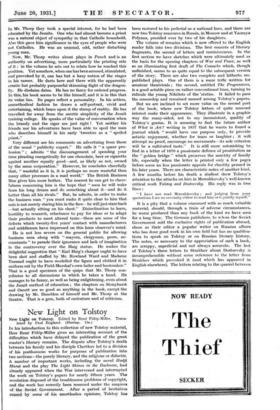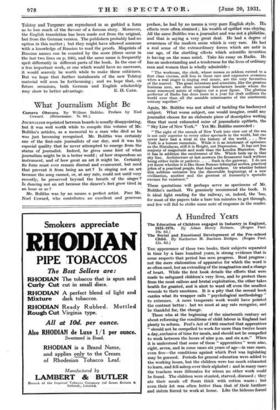New Light on Tolstoy
New- Light on Tolstoy. Edited by Rene FORT-Miller. Trans- lated by Paul England. (Harrap. 15s.) In his introduction to this collection of new Tolstoy material, Herr Rene Mop-Miller gives an interesting account of the difficulties which have delayed the publication of the great master's literary remains. The dispute after Tolstoy's death between his family and his disciple Chertkov led to a division of his posthumous works for purposes of publication into two sections—the purely literary, and the religious or didactic. A number of important works, including the novel Hadji Murat and the play The Light Shines in the Darkness, had already appeared when the War intervened and interrupted the work on Tolstoy's papers for nearly fifteen years. The revolution disposed of the troublesome problems of copyright, and the work has recently been resumed under the auspices. of the Soviet Government. After a --period of hesitation) caused by some of his . unorthodox opinions, Tolstoy- has
been restored to his pedestal as a national hero, and there are now two Tolstoy museums in Russia, in Moscow and at Yasnaya Polyana, presided over by two of his daughters.
The volume of remains which is now offered to the English reader falls into two divisions. The first consists of literary fragments, the second of letters and reminiscences. In the first section we have sketches which were ultimately used as the basis for the opening chapters of War and Peace, as well as an illuminating first draft of The Cossacks which, though unfinished, seems to us quite equal to the subsequent version of the story. There are also two complete and hitherto un- published plays. One of them is a mere trifle written for amateur theatricals ; the second, entitled The Progressives, is a good actable piece on rather conventional lines, turning to ridicule the young Nihilists of the 'sixties. It failed to pass the censorship and remained unused among Tolstoy's papers.
But we are inclined to set more value on the second part of the book, where new Tolstoy letters of quite unusual interest make their appearance. They illustrate in a graphic way the many-sided, not to say inconsistent, quality of Tolstoy's genius. It is amusing to find the future author of What is Art? writing in 1857 that he wants to found a journal which " would have one purpose only, to provide artistic enjoyment, whether for tears or laughter ; it will attempt no proof, encourage, no movements—its sole criterion, will be a cultivated taste." It is still more astonishing to find in a letter of 1870 a passionate defence of prostitution as the " golden bridge " which preserves the sanctity of family life, especially when the letter is printed only a few pages before some no less passionate appeals for chastity penned in his later years. There are characteristic notes of another kind. A few months before his death a student drew Tolstoy's attention to the attacks on him in Merezhkovsky's well-known critical work Tolstoy and Dostoevsky. His reply was in two lines : " I have not read Merezhkovsky ; and judging from your quotations I see no necessity either to read him or to justify myself."
It is a pity that a volume crammed with so much valuable material, should, through a train of adverse circumstances, be worse produced than any book of the kind we have seen for a long time. The German publishers, to WAOM the Soviet Government sold the exclusive rights of publication abroad, chose as their editor a popular writer on Russian affairs who has done good work in his own field but has no qualifica- tions to speak on Tolstoy or on Russian literary history. The notes, so necessary to the appreciation of such a book, are scrappy, superficial and not always accurate. _ The last of Tolstoy's three letters to Strakhov about Dostoevsky is incomprehensible without some reference to the letter from Strakhov which provoked it (and which has appeared in English elsewhere). The letters relating to the quarrel between Tolstoy and Turgenev are reproduced in so garbled a form as to lose much of the flavour of a famous story. Moreover, the English translation has been made not from the original, but from the German version. The publishers probably had no option in this matter ; but they might have allowed someone with a knowledge of Russian to read the proofs. Misprints of Russian names can be counted by the score (three occur in the last two lines on p. 240), and the same name is frequently spelt differently in different parts of the book. In the case of a less important work, or one which would have no successor, it would scarcely be worth while to make these criticisms. But we hope that further instalments of the new Tolstoy, material will soon be forthcoming ; and we hope that, on future occasions, both German and English scholarship may show to better advantage. E. H. Cann.











































 Previous page
Previous page